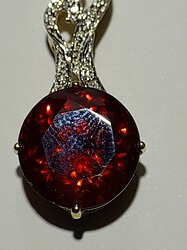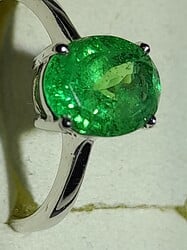Hi
I am seeking peoples opinions on these 2 gemstones please?
Thank you
It’s really hard to tell from just the pictures. If I had to guess I might say garnet for both of them? Something in the Hessonite family for the top one and maybe Tsavorite for the green one. Just based on color. You can get an RI reading off them while in the setting, That might narrow it down a little.
thank you
I thought for the first stone Spessartite garnet and the second stone a Tsavorite.
I’m going a little differently on the second one, possibly moldavite, helenite or something similar. Possibly green glass. Looks to me like it has a bunch of air bubbles. Not sure if it is just the picture tho
I don’t see any bubbles in it, I think it is very sparkly ( the reflection of light passing through it)
thank you for your opinion.
Opinions aren’t worth much if they aren’t buttressed by data and there’s precious little in your photos. If they were microscope photos at 10X or more, they might help, but still might not be totally reliable for ID. the stones are mounted, so you can’t do an SG, even tho’ if they were loose, you could do one with a $12 scale. You’d really need a refractometer to start your ID and then perhaps a loupe would help if you read up on inclusions. Refractometer about $75-$100 on ebay…
Yes, your red stone could be spessartite, but it could be hessonite, too, or maybe even ruby or madeira citrine. Madeira isn’t often that dark in what seems like a fairly small stone, but could be. Or even some kind of pyrope or pyrope/almandine…the color just isn’t really clear to me. The green one could be tsavorite, but it could be emerald or something else. To be sure, you need to test it. -royjohn
hi,
thank you.
I believe the more questions you ask it becomes more ease to understand.
So the refractometer gives you the RI of the stone and the microscope 10x or more helps identify the inclusions but what about the the crystal system does this help?
thanks
Well, the British gemological education includes a lot of work on the various crystal systems, but for practical gemology in identifying stones, I can’t see where it’s very important. I can ID a lot of stones but I doubt I could tell you all the crystal systems…
As far as the refractometer, the simplest thing to do with it is read an RI…or two RIs in the case of doubly refractive stones. However, that isn’t all you can do with a refractometer. Looking at the “rainbows” in it you can estimate the dispersion of the material, which is also a clue to ID. When you see either one or two readings, you know whether the stone is birefringent or not. If you manipulate the stone a little [not going into all of this here, there is a great article on the refractometer and optic character and optic sign and also crystal systems here: https://ruby-sapphire.com/articles/821-crystal-optics ] you can determine the optic sign and optic character of it, too. With all that info, you should have an ID, except that you won’t know for sure whether it is natural or synthetic if it falls into an RI range where it could be synthetic…not all gems have a synthetic counterpart, so in some RI ranges it has to be natural. That’s where the stereo microscope comes in…you can judge clarity for valuation with one and you can see the inclusions at 10X to 60X, and, if you know which inclusions indicate natural vs synthetic, you can differentiate between the two. You need lots of practice with the microscope and need to look at a lot of stones to nail all the IDs of all the synthetics, as there are three or four different processes to make synthetics and they all have different types of inclusions. It also helps to have access to a library of inclusion photos to match what you are seeing in the 'scope to. These used to be available only in expensive books, but now if you look carefully, you can find large libraries of inclusion photos on line…
Crystal systems don’t help you much with cut stones because you can’t see a crystal shape any more.
If you’re looking for gem knowledge, a good place to start is a free on line course by Barbara Smigel. Another place to start is the book, Gem ID Made Easy, by Antoinette Matlins. There are numerous editions of this, so you can get a used copy of an old edition for cheap (just isn’t completely up to date on new synthetics, like lab diamonds) if $$$ is a problem. Beyond that is Hanneman’s Affordable Gemology. The for-pay courses boil it all down for you and give you a certificate, but these two books and maybe a couple others and the on line course will give you a lot of ID knowledge. Gem valuation requires price guides and a lot of hunting around looking for current prices on line and through suppliers…hope this helps…if you just have a few gems which you want to know about, wait for a local Gem and Mineral Show and they will often have an ID table manned by volunteer geologists and gemologists who will ID and give you a seat of the pants appraisal. Contact you local Gem and Mineral Society and ask them about this or someone, maybe a knowledgeable hobbiest, who might help…HTH, -royjohn
Oh, may I also add that you need the refractometer because your stones are already mounted and you can’t measure their specific gravity. As Hanneman mentions, you can use a whole different system to ID if you have loose stones or rough, based on specific gravity (SG). However, a complete system without a refractometer would require use of a polariscope (prolly a similar outlay to a refractometer for a good one)…with a strainless sphere and a “substitute quartz wedge” (wow, we’re really getting into the weeds now!) you can, if you are good at it, determine optic character and optic sign. This involves manipulating the stone until you find a funny looking optical figure, but I won’t go into that here, as the refractometer is so much easier for faceted stones…but you can look it up on line. A polariscope is a lot easier to take into the field if you are buying gem rough…-royjohn
Hi Everyone,
I thought I would give you an update of the green gemstone in the ring as I had it tested by qualified Gemologist and it tests results indicated that it is a Tsavorite garnet.
Lovely for me
Thank you
I’m wondering what a gemologist charges for a simple ID like this one…might
have to hang up my shingle…-royjohn
Hi,
Do you think I would succeed in selling jewellery if I also did the valuation for the item?
Thank you
Hi royjohn,
For a simple ID of a loose gemstone, I paid US$35 + shipping both ways to GCAL.
Hope this helps




